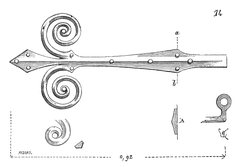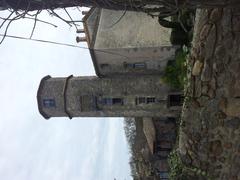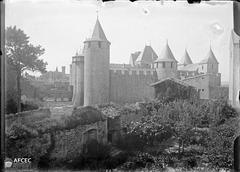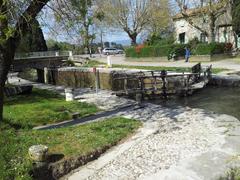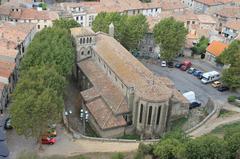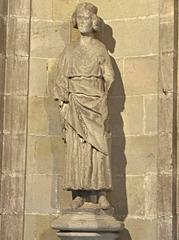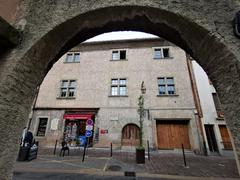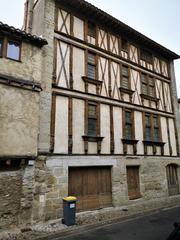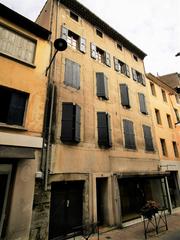Grand Well Carcassonne: Visiting Hours, Tickets, and Complete Travel Guide
Date: 14/06/2025
Introduction
The Grand Well (Le Grand Puits) stands as a remarkable emblem of medieval ingenuity within the fortified city of Carcassonne, a UNESCO World Heritage site in southern France. Dating to the 12th or 13th century, this deep, stone-lined well was pivotal to Carcassonne’s survival during sieges and remains a fascinating site for visitors today. This authoritative guide outlines the Grand Well’s historical significance, architectural features, visiting hours, ticketing details, accessibility, nearby attractions, visitor tips, and more to ensure a rewarding experience for all travelers (France Voyage; Occitanie Travel; Grand Carcassonne Tourisme; UNESCO).
Historical Overview: Origins and Construction
Located at the heart of the Cité Médiévale, the Grand Well is one of several wells within Carcassonne, but it stands out for its size and strategic importance. Constructed during major fortification works under the Trencavel lords and Capetian kings, the well provided a reliable water source for both residents and defenders. Historical and archaeological evidence suggests the well reaches depths exceeding 20–30 meters, a testament to medieval engineering (France Voyage; GPSmyCity).
Engineers of the time excavated deep into the bedrock to ensure access to groundwater even in the face of long sieges, such as those during the Albigensian Crusade. The well’s wide shaft accommodated the needs of a substantial population, including soldiers and livestock, underscoring its vital role in Carcassonne’s defensive system (History Skills; France Today).
Strategic and Social Significance
Military Importance:
The Grand Well’s position within the inner walls meant uninterrupted access to fresh water, even if the city’s outer defenses fell. This redundancy, complemented by other cisterns like the Fount Celado, was deliberate—ensuring Carcassonne could survive protracted blockades (History Skills).
Daily Life and Community:
Beyond its military function, the well was central to daily medieval life. Residents gathered here for water, conversation, and news, making it a hub of social interaction. Local lore, including the legend of Dame Carcas who tricked besiegers by demonstrating the city’s apparent abundance, highlights the well’s symbolic role in community resilience (The Good Life France).
Architectural Features and Preservation
The Grand Well’s wide, circular stone shaft and robust masonry reflect the skill of medieval masons. The mouth is protected by a wrought-iron grille and parapet for safety. Significant restoration, particularly under 19th-century architect Eugène Viollet-le-Duc, preserved the well’s structure as an integral element of the city’s heritage (UNESCO; L’Occitane Carcassonne).
Visiting the Grand Well: Hours and Tickets
Location and Access
The Grand Well is situated near the main pathways connecting the Château Comtal and Basilica of Saint-Nazaire inside the Cité de Carcassonne. Signposted walking routes guide visitors directly to the well (Sacavoyage).
Visiting Hours
- April–September: 10:00 AM – 6:30 PM (last admission 5:30 PM)
- October–March: 9:30 AM – 5:00 PM (last admission 4:00 PM)
- Closed: January 1, May 1, December 25
Check the official Remparts Carcassonne website for updates, as hours can vary seasonally.
Tickets and Admission
Access to the Grand Well is included with the general Château Comtal and ramparts ticket; no separate ticket is required for the well itself.
- Adult: ~€13 (peak season)
- Discounts: Reduced rates for children, students, and disabled visitors; free for those under 18 and visitors with disabilities (Billets Carcassonne)
- Purchase: Tickets available onsite or online through official tourism sites.
Entry to the Cité de Carcassonne is free; tickets are only needed for the castle, ramparts, and certain guided experiences.
Accessibility
The Grand Well is generally accessible, though the citadel’s cobblestones and uneven terrain may pose challenges. Main routes to the well are navigable for most visitors, but those with mobility concerns may require assistance. Wheelchair users can access key areas, but some medieval streets remain difficult (Billets Carcassonne).
Guided Tours and Interpretation
The Grand Well is featured in many guided tours and audio guides, available in several languages (Remparts Carcassonne). Booking a tour through the official website or visitor center enriches the experience with historical context and storytelling.
Visitor Tips
- Best Time to Visit: Early mornings or late afternoons, especially on weekdays, to avoid peak crowds (France Travel Guide)
- Photography: The well is photogenic, especially in soft morning or evening light. Please respect other visitors.
- Facilities: There are no dining options inside the castle complex, but cafés and restaurants are plentiful just outside the walls.
- Duration: Plan at least 2 hours to explore the Grand Well, castle, ramparts, and basilica.
Myths, Legends, and Cultural Events
The Grand Well is woven into Carcassonne’s folklore and annual festivities. Dame Carcas’s legendary defense is often recounted during festivals and guided tours (History Tools).
Notable Events
- Festival de Carcassonne (July): Concerts, theater, and dance performances near the Grand Well (Maison Carcassonne)
- Bastille Day Fireworks (July 14): The well’s plaza offers panoramic views of the city’s spectacular fireworks (France Voyage)
- Remparts et Lumières: Night tours and light shows from mid-July to mid-September (Grand Carcassonne Tourisme)
Nearby Attractions
- Château Comtal: Medieval castle with panoramic views and historical displays
- Basilica of Saint-Nazaire: Notable for Gothic-Romanesque architecture and stained glass
- City Ramparts: Walkable fortifications with sweeping views
- Local Markets and Gastronomic Festivals: Weekly markets and food festivals often center around the Grand Well (Grand Carcassonne Tourisme)
Practical Tips and Essential Information
- Location: Central Cité de Carcassonne, near Château Comtal and Basilica of Saint-Nazaire
- Depth: Estimated 20–30 meters (65–100 feet)
- Admission: Included with castle and ramparts ticket; free access to the Cité
- Best Visit Duration: 2+ hours for the full citadel experience
- Safety: The well is protected by a grille; supervise children and respect barriers (Remparts Carcassonne)
- Facilities: Restrooms are within the Cité; dining just outside city walls
Frequently Asked Questions (FAQ)
Q: What are the Grand Well’s visiting hours?
A: From April to September, 10:00 AM–6:30 PM; from October to March, 9:30 AM–5:00 PM. Closed January 1, May 1, and December 25.
Q: Is a separate ticket required for the Grand Well?
A: No. Access is included with the general admission ticket for Château Comtal and ramparts.
Q: Is the Grand Well accessible for visitors with mobility concerns?
A: The main routes are accessible, but some areas are uneven. Assistance may be needed for wheelchair users.
Q: Can I take photos at the Grand Well?
A: Yes, photography is permitted.
Q: Are guided tours available?
A: Yes, many guided tours and audio guides include the Grand Well.
Visuals and Media
For enhanced planning and engagement, consult the official Remparts Carcassonne and Grand Carcassonne Tourisme websites for high-quality images, virtual tours, and interactive maps.
Summary and Call to Action
The Grand Well of Carcassonne is not only a marvel of medieval engineering but also a vibrant symbol of the city’s resilience, community, and cultural life. Its preservation allows visitors to connect with centuries of history, from epic sieges to lively local festivals. For a fulfilling visit, plan ahead by consulting official sources for current hours and ticketing, and consider joining a guided tour for deeper insights.
Plan your visit today—download the Audiala app for audio guides and interactive maps, and explore related articles on Carcassonne’s heritage. Follow us on social media or subscribe to our newsletter for the latest travel updates, tips, and exclusive content.
Sources
- France Voyage
- Occitanie Travel
- Grand Carcassonne Tourisme
- History Skills
- France Today
- UNESCO
- Remparts Carcassonne
- Maison Carcassonne
- Billets Carcassonne
- Sacavoyage
- The Good Life France
- History Tools

